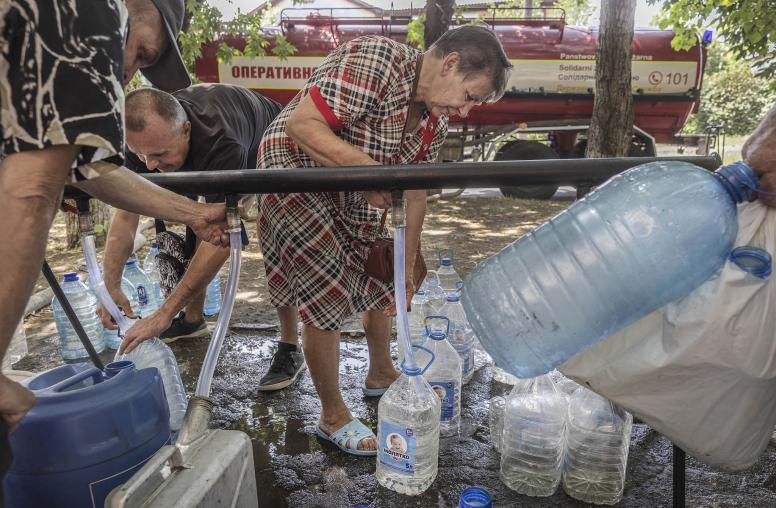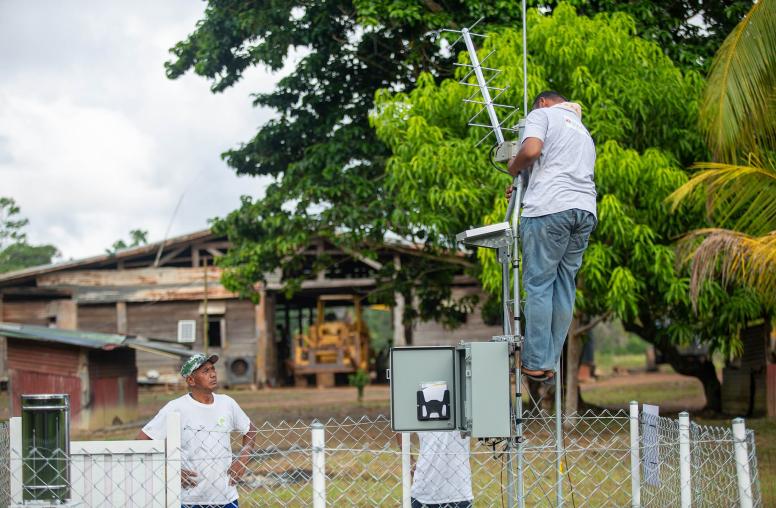Tegan Blaine on How Climate Change Impacts Global Conflict
USIP’s Tegan Blaine says we must be cognizant of how efforts to reduce climate change can exacerbate instability and conflict, as the resources needed for a greener global economy “are in places where the countries are already politically fragile” and higher demand adds more stress to already burdened institutions.
On Peace is a weekly podcast sponsored by USIP and Sirius XM POTUS Ch. 124. After a brief hiatus, On Peace is available again on a weekly basis. Each week, USIP experts tackle the latest foreign policy issues from around the world.
Transcript
Julie Mason: Julie Mason, joining me now: Dr. Tegan Blaine, senior advisor on environment and conflict at the U.S. Institute of Peace. Prior to joining the Institute in 2020, she was vice president on climate change initiative at the National Geographic Society. Here to discuss the intersection of environment and conflict. Dr. Blaine, good morning.
Tegan Blaine: Good morning. Thank you so much for inviting me on.
Julie Mason: Well, it's great to have you. I was saying earlier that climate and conflict used to be things we've talked about separately, but now they have been conflated, conjoined.
Tegan Blaine: They have, and I think for good reasons.
Julie Mason: Yeah, tell us how climate change affects conflict.
Tegan Blaine: You know, there are a few different ways that climate change is likely to affect conflict. It happens on both sides of the climate change continuum. On one side, we talk about what we can do to reduce climate change, which is often involved with reducing greenhouse gas emissions that come from the use of energy and changes in how we manage land. On the other side, we talk about how climate change is affecting people's lives through increased heat emergencies, through changes in rainfall, changes in temperature. Both sides can lead to conflict for very, very, very different reasons.
Julie Mason: Yeah, I was gonna say on the first side, because I understand how, for example, a drought causes conflict, but on the other side, like on the first side, how do we get to conflict there?
Tegan Blaine: Very easily. You know, already in the transition to a global green economy, we are beginning to see conflicts increase. All of the technologies that are required for a new green economy, require different minerals and different resources than we have necessarily used in the past. And so many countries, and many companies as individual companies are beginning to see that their demand for certain minerals is increasing. And a lot of those minerals are in places where the countries are already politically fragile, for example, places like the Democratic Republic of Congo in Africa. And so if you think about the demand for these minerals increasing, so for example, by 2050, demand for minerals like cobalt, and lithium could surge by 500%. And when you think about the countries where many of these minerals are located, we have to begin thinking about the conflicts that those can cause.
Julie Mason: Wow, that's so interesting. And so then on the other end, tell us how these things happening there. There's also short term and long term considerations, right, Dr. Blaine?
Tegan Blaine: Absolutely, absolutely. Climate change impacts things like heat emergencies, which we have seen play out already in the United States this year in devastating ways. But it also impacts things like ability to grow produce and access water and things like that. And many of those are driven by longer term changes that take a long time to play out. And so in many ways, climate change is already beginning to threaten people's water security, their food security, even what I call their health security, when we come to things like heat emergencies.
And so all of those are quite concerning. You know, they threaten people's sense of stability and when you see that crop productivity and access to water is dropping, sometimes it forces people into very difficult decisions, to actually whether temporarily or permanently abandon the place that they're living and go seek out better conditions elsewhere. This is something that human beings have been doing for thousands of years. But what's happening now is it's likely to increase stresses on cities and other societies that are receiving all of these immigrants who are coming in with personal issues and challenges already.
Julie Mason: I think it's so fascinating that the these phenoms are converging on cities, you know, because I think when we picture it, it's seems like an almost rural or remote issue, but now as you write convincingly, very, very prevalent pressure on cities.
You know, there has not been nearly as much as much research on cities and that concerns me. To me, it's a place that we really need to focus, especially in the Global South, when people are migrating, whether it's because they're looking for a short term job, or because they're looking to move over the long run, oftentimes, they're going to what are considered peri-urban areas. They're on the outskirts of cities. They often don't have water supplies, they don't have trash collection, people are building houses out of any materials that they can find. And so a lot of people coming into cities are cut off economically and socially, from what's actually going on in the city.
Tegan Blaine: It creates a very challenging situation. And also people who have been in cities traditionally, for a very long time, can resent the the new people coming in. Many of these cities oftentimes don't have very strong governments to begin with and are already struggling to deal with the social and economic upheavals. And so this creates a situation where governments are struggling to deal with the incoming people, those people are already dealing with being on the outside of cities, and it creates, potentially, a very challenging situation,
Julie Mason: I thought it was so fascinating that you note that research from Mexico shows that while lack of economic opportunities figures large in migrants' explanations about why they migrate, it is personal exposure to violence that drives their actual decision to leave.
Tegan Blaine: Yes, and I think we are going to see more of this. And you know, many immigrants do not necessarily mention climate change when they say that they're moving, what they mentioned is other challenges. But increasingly, you know, we're seeing that people are ending up in cities, because of challenges that are associated with climate change and finding themselves in unlivable situations. And so they're moving on to search for additional places, and additional places where they can actually settle and have reasonable lives. Violence is one of those drivers that's going to cause people to move on and we are beginning to see this in places like Central America. I wouldn't be surprised if we see it in other areas of the world in the future.
Julie Mason: One tiny example, but an important one, you write: collaboration on responding to environmental risks can be a powerful unifier and responding to climate change may be even moreso. For example, an initiative to build urban green spaces in post-conflict Colombia has increased social cohesion and communities with significant percentages of displaced peoples. It can help.
Tegan Blaine: I hope so. And again, I think that this is an area where we have to do a lot more work. You know, there was a period when I was in Nepal during the Maoist rebellion, working on environment issues, and I cannot take credit for the majority of this work, but what we were seeing was that towns that had worked on environmental issues and had really built their decision-making power, built their communities, the sense of what they wanted to achieve and how they were going to achieve it, were able to better resist the Maoist incursion. And that to me gives hope that we can apply the same principles in many other environmental disciplines. ]
You know, the United Nations Environment Program has done quite a bit of research on the impact of environment and conflict. And they have discovered that an enormous number of conflicts are due, in the end, to environmental challenges. And also when those environmental challenges are not addressed as part of the peace process, those peace processes are more likely to fail. I do think we need to be taking these environmental issues more seriously, and addressing them as part of larger peace processes.
Julie Mason: Really fascinating work. Dr. Tegan Blaine, senior advisor on environment and conflict at the U.S. Institute of Peace. Dr. Blaine, thank you so much for joining me.
Tegan Blaine: Thank you so much for having me.
Julie Mason: Have a good day.



